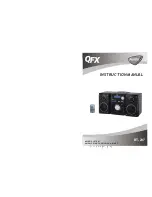
5
blastking.com
INSTALLATION
Before connecting to mains power, make sure that the switches are set to the configuration needed for your particular application. Always switch the equalizer off
before making any changes to the settings. Failure to do so could result in damage to the unit or other components in your system. Use four screws and washers
when rack mounting the Equalizer. For mobile use, the unit should be further secured as appropriate.
General Requirements
The ULTRAMIX 3102-EQ equalizer have specific physical, electrical and signal requirements for proper operation. These requirements will vary depending on your
specific application, setup, and the settings on the equalizer. When setting up and testing your system, please take special care to double check all connections and
settings. Please refer to the specifications section of this manual for specific input, output and other figures.
AC Power
Your ULTRAMIX 3102-EQ equalizer should be connected to a standard 3- wire grounded electrical outlet supplying 100-240 Volts, 50-60 Hz. To reduce the risk
of ground loop hum, connect all audio equipment to the same electrical power source. Do not remove the AC plug ground pin, as a potential shock hazard could
result.
This unit will perform normally within the AC voltage range specified above. Voltages less than this, as found in “brown-out” conditions, may reduce performance.
No user serviceable parts are inside the chassis. Refer all servicing to qualified service personnel. Overall power consumption is less than 30 watts.
NOTE: The power switch does NOT isolate the appliance from mains. Make sure the mains power socket or an alternative disconnect device is near by and easily
accessible. When the product is connected to mains, the line-filter and the input of the fuse are energized.
TYPICAL APPLICATIONS
The following information will help you make the most of your new equalizer:
General Tone Control
The graphic equalizer is a very useful device for general tone shaping because it is intuitive and easy to adjust. The visual reference provided by the slider position
gives an approximate idea of the frequency response generated, with the lower frequencies on the left and higher frequencies on the right. To use the power of an
equalizer effectively, you need to translate your idea of the tone you want to produce into a range of numerical frequencies. This is simple after a little practice.
Here are a few references which are useful for starting points:
Very low bass (the “wind” in a kick drum, almost felt as much as heard -40Hz-80Hz.
The low register of a male voice - 200Hz
The low register of a female voice - 350Hz
Lower midrange (“warmth” frequencies) - 400Hz-1KHz
Upper midrange (“harshness”, snare drum “bite”, “hot” sound) -2.5KHz-4KHz.
Sibilance (“sss” sounds, cymbal “sizzle”) - 8KHz-15KHz.
Try using these starting points as a guide when you want more or less of these types of sounds. Adjust by ear from there. It is always a good idea to remember that
a little equalization usually works out much better than a lot, and that there are many audio problems which can not be solved with equalization alone.
Feedback Control
A graphic equalizer can be used to provide some control over moderate feedback problems, but does not have enough flexibility or resolution to handle severe
situations. You will achieve the best results when you can eliminate one or two feedback points by setting one or two sliders for no more than a 6dB cut. Often you
can find a feedback point by boosting sliders in succession to determine which frequency ranges contain the feedback modes, and then cutting those ranges. Be
very careful in this process to avoid explosive feedback and possible system and hearing damage. If you find feedback points with many equalizer bands, cutting
every band may not help (all you will do is reduce system gain). The combination of a graphic equalizer for tone control and a parametric equalizer for feedback
control is highly recommended.


























